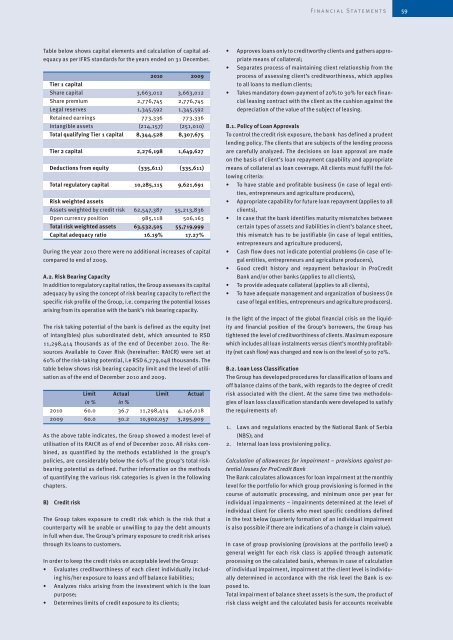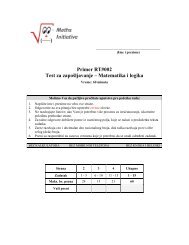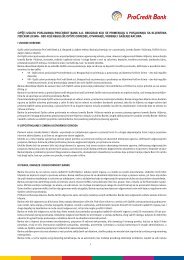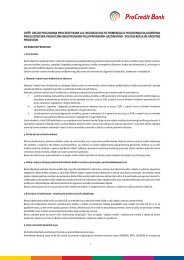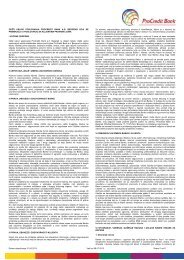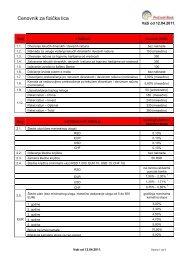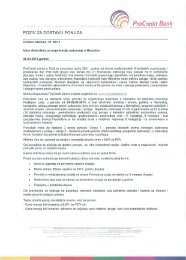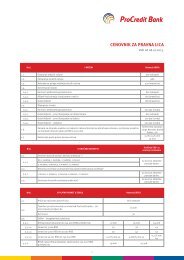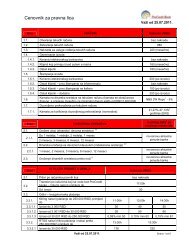Annual Report 2010 - ProCredit Bank
Annual Report 2010 - ProCredit Bank
Annual Report 2010 - ProCredit Bank
- No tags were found...
Create successful ePaper yourself
Turn your PDF publications into a flip-book with our unique Google optimized e-Paper software.
Financial Statements 59<br />
Table below shows capital elements and calculation of capital adequacy<br />
as per IFRS standards for the years ended on 31 December.<br />
Tier 1 capital<br />
<strong>2010</strong> 2009<br />
Share capital 3,663,012 3,663,012<br />
Share premium 2,776,745 2,776,745<br />
Legal reserves 1,345,592 1,345,592<br />
Retained earnings 773,336 773,336<br />
Intangible assets (214,157) (251,010)<br />
Total qualifying Tier 1 capital 8,344,528 8,307,675<br />
Tier 2 capital 2,276,198 1,649,627<br />
Deductions from equity (335,611) (335,611)<br />
Total regulatory capital 10,285,115 9,621,691<br />
Risk weighted assets<br />
Assets weighted by credit risk 62,547,387 55,213,836<br />
Open currency position 985,118 506,163<br />
Total risk weighted assets 63,532,505 55,719,999<br />
Capital adequacy ratio 16.19% 17.27%<br />
During the year <strong>2010</strong> there were no additional increases of capital<br />
compared to end of 2009.<br />
A.2. Risk Bearing Capacity<br />
In addition to regulatory capital ratios, the Group assesses its capital<br />
adequacy by using the concept of risk bearing capacity to reflect the<br />
specific risk profile of the Group, i.e. comparing the potential losses<br />
arising from its operation with the bank’s risk bearing capacity.<br />
The risk taking potential of the bank is defined as the equity (net<br />
of intangibles) plus subordinated debt, which amounted to RSD<br />
11,298,414 thousands as of the end of December <strong>2010</strong>. The Resources<br />
Available to Cover Risk (hereinafter: RAtCR) were set at<br />
60% of the risk-taking potential, i.e RSD 6,779,048 thousands. The<br />
table below shows risk bearing capacity limit and the level of utilisation<br />
as of the end of December <strong>2010</strong> and 2009.<br />
Limit Actual Limit Actual<br />
in % in %<br />
<strong>2010</strong> 60.0 36.7 11,298,414 4,146,018<br />
2009 60.0 30.2 10,902,057 3,295,909<br />
As the above table indicates, the Group showed a modest level of<br />
utilisation of its RAtCR as of end of December <strong>2010</strong>. All risks combined,<br />
as quantified by the methods established in the group’s<br />
policies, are considerably below the 60% of the group’s total riskbearing<br />
potential as defined. Further information on the methods<br />
of quantifying the various risk categories is given in the following<br />
chapters.<br />
B) Credit risk<br />
The Group takes exposure to credit risk which is the risk that a<br />
counterparty will be unable or unwilling to pay the debt amounts<br />
in full when due. The Group’s primary exposure to credit risk arises<br />
through its loans to customers.<br />
In order to keep the credit risks on acceptable level the Group:<br />
• Evaluates creditworthiness of each client individually including<br />
his/her exposure to loans and off balance liabilities;<br />
• Analyzes risks arising from the investment which is the loan<br />
purpose;<br />
• Determines limits of credit exposure to its clients;<br />
• Approves loans only to creditworthy clients and gathers appropriate<br />
means of collateral;<br />
• Separates process of maintaining client relationship from the<br />
process of assessing client’s creditworthiness, which applies<br />
to all loans to medium clients;<br />
• Takes mandatory down-payment of 20% to 30% for each financial<br />
leasing contract with the client as the cushion against the<br />
depreciation of the value of the subject of leasing.<br />
B.1. Policy of Loan Approvals<br />
To control the credit risk exposure, the bank has defined a prudent<br />
lending policy. The clients that are subjects of the lending process<br />
are carefully analyzed. The decisions on loan approval are made<br />
on the basis of client’s loan repayment capability and appropriate<br />
means of collateral as loan coverage. All clients must fulfil the following<br />
criteria:<br />
• To have stable and profitable business (in case of legal entities,<br />
entrepreneurs and agriculture producers),<br />
• Appropriate capability for future loan repayment (applies to all<br />
clients),<br />
• In case that the bank identifies maturity mismatches between<br />
certain types of assets and liabilities in client’s balance sheet,<br />
this mismatch has to be justifiable (in case of legal entities,<br />
entrepreneurs and agriculture producers),<br />
• Cash flow does not indicate potential problems (in case of legal<br />
entities, entrepreneurs and agriculture producers),<br />
• Good credit history and repayment behaviour in <strong>ProCredit</strong><br />
<strong>Bank</strong> and/or other banks (applies to all clients),<br />
• To provide adequate collateral (applies to all clients),<br />
• To have adequate management and organization of business (in<br />
case of legal entities, entrepreneurs and agriculture producers).<br />
In the light of the impact of the global financial crisis on the liquidity<br />
and financial position of the Group’s borrowers, the Group has<br />
tightened the level of creditworthiness of clients. Maximum exposure<br />
which includes all loan instalments versus client’s monthly profitability<br />
(net cash flow) was changed and now is on the level of 50 to 70%.<br />
B.2. Loan Loss Classification<br />
The Group has developed procedures for classification of loans and<br />
off balance claims of the bank, with regards to the degree of credit<br />
risk associated with the client. At the same time two methodologies<br />
of loan loss classification standards were developed to satisfy<br />
the requirements of:<br />
1. Laws and regulations enacted by the National <strong>Bank</strong> of Serbia<br />
(NBS); and<br />
2. Internal loan loss provisioning policy.<br />
Calculation of allowances for impairment – provisions against potential<br />
losses for <strong>ProCredit</strong> <strong>Bank</strong><br />
The <strong>Bank</strong> calculates allowances for loan impairment at the monthly<br />
level for the portfolio for which group provisioning is formed in the<br />
course of automatic processing, and minimum once per year for<br />
individual impairments – impairments determined at the level of<br />
individual client for clients who meet specific conditions defined<br />
in the text below (quarterly formation of an individual impairment<br />
is also possible if there are indications of a change in claim value).<br />
In case of group provisioning (provisions at the portfolio level) a<br />
general weight for each risk class is applied through automatic<br />
processing on the calculated basis, whereas in case of calculation<br />
of individual impairment, impairment at the client level is individually<br />
determined in accordance with the risk level the <strong>Bank</strong> is exposed<br />
to.<br />
Total impairment of balance sheet assets is the sum, the product of<br />
risk class weight and the calculated basis for accounts receivable


